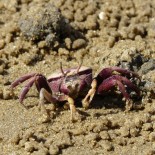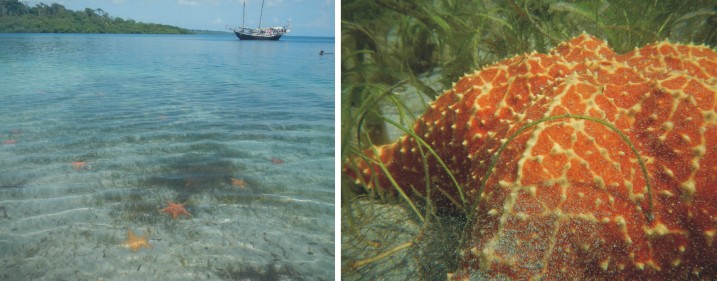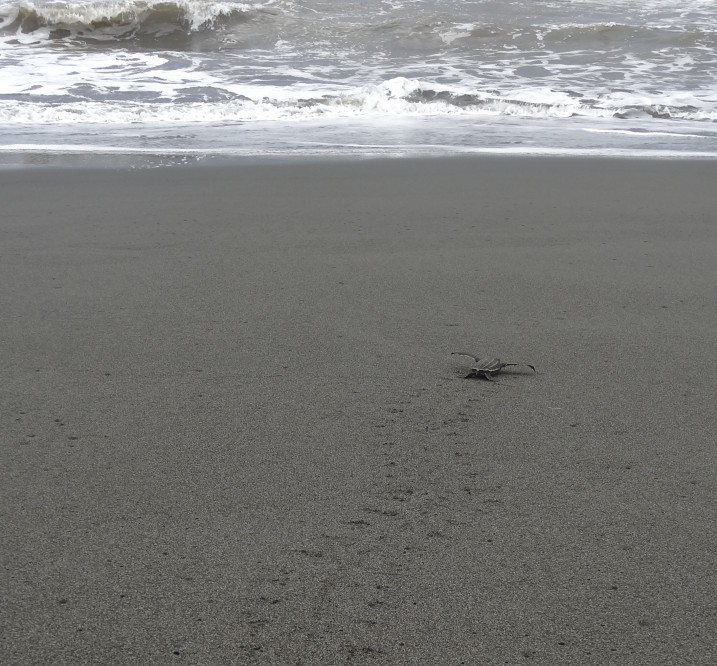Aktuopaläontologie in Caribbean Panama
When we paleontologists look at the modern world, most often we can’t help but thinking in our beloved fossil record. I would say that this is particularly true for taphonomists and ichnologists. We see a corpse (hopefully not human), and begin speculating about how long had it been laying there or which are its chances to fossilize. An accumulation of seashells on the beach triggers dreamy thoughts of how much transport have they suffered or what can they tell us about sedimentary dynamics. An open hole in the sand is a door open into the subterranean world of tracemakers whose work is often beautifully recorded in sedimentary rocks.
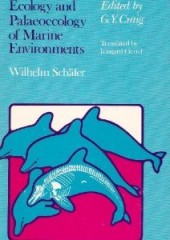 This way of looking at the natural world is probably as old as palaeontology or even more, but it was made it into a science in the Germany of the beginning of the XXth century. The main character in this story was Rudfol Richter who not only considered this approach a subdiscipline of paleontology and coined a term for it, Aktuopaläontologie, but was also the founder of the Senckenberg am Meer Institute in Wilhelmshaven, which was entirely devoted to the study of actuogeology and actuopaleontology. This was the starting point of a very successful enterprise which has produced many interesting contributions to taphonomy, ichnology, paleoecology, and sedimentology (see recent review by Cadée and Goldring 2007). This works culminated with the excellent book by Wilhelm Schäfer Aktuo-Paläontologie nach Studien in der Nordsee (1962), which was later translated to English as Ecology and paleoecology of marine environments (1972). This is one of my favourite paleontological books and contains a lot of specific data that often come in handy when trying to understand the fossil record. Having that book in your shelf or library if you care about taphonomy or ichnology is a must.
This way of looking at the natural world is probably as old as palaeontology or even more, but it was made it into a science in the Germany of the beginning of the XXth century. The main character in this story was Rudfol Richter who not only considered this approach a subdiscipline of paleontology and coined a term for it, Aktuopaläontologie, but was also the founder of the Senckenberg am Meer Institute in Wilhelmshaven, which was entirely devoted to the study of actuogeology and actuopaleontology. This was the starting point of a very successful enterprise which has produced many interesting contributions to taphonomy, ichnology, paleoecology, and sedimentology (see recent review by Cadée and Goldring 2007). This works culminated with the excellent book by Wilhelm Schäfer Aktuo-Paläontologie nach Studien in der Nordsee (1962), which was later translated to English as Ecology and paleoecology of marine environments (1972). This is one of my favourite paleontological books and contains a lot of specific data that often come in handy when trying to understand the fossil record. Having that book in your shelf or library if you care about taphonomy or ichnology is a must.
This summer I went on vacations with my wife Inma to Panama. We had a great time visiting the country and we spent some time in the Bocas and Kuna Yala regions of the Caribbean coast. In these areas, the shallow sea, which is bounded by a fringed coral reef, has numerous islands, many of them very small, with white carbonate sandy beaches and some palmtrees, and the continental shore is constituted by a labyrinthine mangroove forest. A wonderful place for an actuopaleontologist, even for one poorly-adapted to marine life as I am. We were on vacation and so, we did not carry out any serious work. Nevertheless, we made some observations and took some pictures that I want to share here.
The Playa de las Estrellas in the Island of Colon in Bocas del Toro gets its name from the abundant starfish that are found lying in the sand and hidden between the seagrass. A good place to think about the influence of seagrasses in carbonate depositional environments and about the reasons for the limited fossil record of asteroids, whose skeleton quickly disarticulates after death.
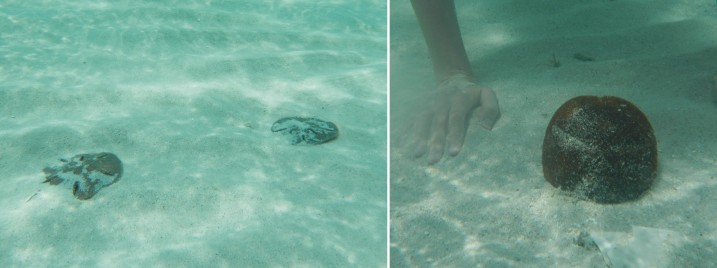 The poor preservation potential of starfishes contrast with that of other echinoderms. Clypeasteroid echinoids (left, from Kuna Yala) have strongly interlocked skeletal plates and internal pillars that reinforce the test allowing them to become common fossils in Cenozoic shallow marine sedimentary rocks (see our recent paper in Lethaia for more details). Spatangoid echinoids (right, also from Kuna Yala) bear less robust tests but they are infaunal and consequently they may die already buried what aids in preservation.
The poor preservation potential of starfishes contrast with that of other echinoderms. Clypeasteroid echinoids (left, from Kuna Yala) have strongly interlocked skeletal plates and internal pillars that reinforce the test allowing them to become common fossils in Cenozoic shallow marine sedimentary rocks (see our recent paper in Lethaia for more details). Spatangoid echinoids (right, also from Kuna Yala) bear less robust tests but they are infaunal and consequently they may die already buried what aids in preservation.
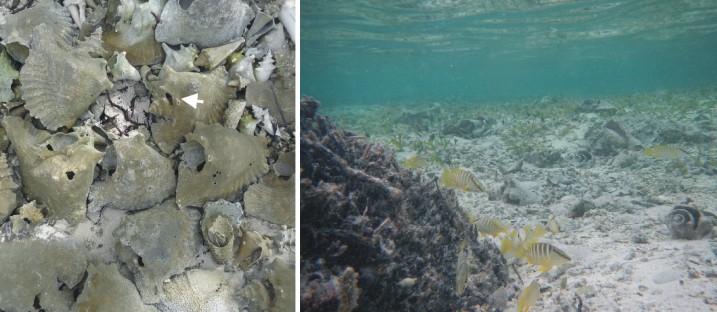 Also very interesting are the conch shell accumulations (Strombus sp.) found in some beaches, particularly in those that had human habitation for long time. These are direct consequence of anthropic action. Locals fish for conches in the reef nearby and take them to the beach where they use a knife to pierce through the shell to free the soft, eatable parts of this mollusk. Such an action produces a very characteristic elongated hole in the shells that can be seen in every single one of them (arrow in left picture). Such accumulations and bioerosion traces are unlikely to be found in the fossil record (because of its anthropic origin), although human-produced mollusk shell deposits may be found in archaeological sites. Nevertheless, another lesson is there to be explored for the actuopaleontologist as those conch shells have been accumulated for decades, maybe even centuries, and a great variety of preservational variants recording a whole range of taphonomic histories can be found.
Also very interesting are the conch shell accumulations (Strombus sp.) found in some beaches, particularly in those that had human habitation for long time. These are direct consequence of anthropic action. Locals fish for conches in the reef nearby and take them to the beach where they use a knife to pierce through the shell to free the soft, eatable parts of this mollusk. Such an action produces a very characteristic elongated hole in the shells that can be seen in every single one of them (arrow in left picture). Such accumulations and bioerosion traces are unlikely to be found in the fossil record (because of its anthropic origin), although human-produced mollusk shell deposits may be found in archaeological sites. Nevertheless, another lesson is there to be explored for the actuopaleontologist as those conch shells have been accumulated for decades, maybe even centuries, and a great variety of preservational variants recording a whole range of taphonomic histories can be found.
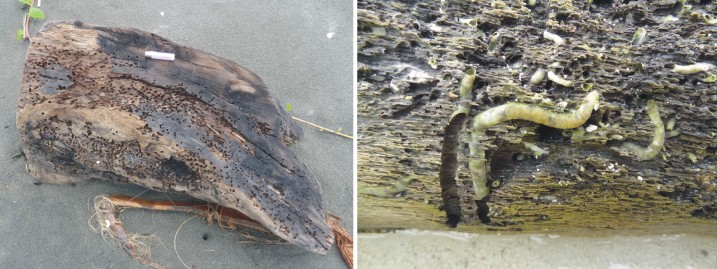 Another mollusk that abounds in the shores of Panama is the shipworm (Teredo). This bivalve bores into floating logs carried into the sea by rivers or storms. Its characteristic borings are long, contorted, cylindrical structures, lined with a thin calcite veneer. Such borings are common in the fossil record since the Jurassic and known as Teredolites longissimus. In the beaches and islands of Caribbean Panama is common to find stranded logs heavily perforated by these voracious clams.
Another mollusk that abounds in the shores of Panama is the shipworm (Teredo). This bivalve bores into floating logs carried into the sea by rivers or storms. Its characteristic borings are long, contorted, cylindrical structures, lined with a thin calcite veneer. Such borings are common in the fossil record since the Jurassic and known as Teredolites longissimus. In the beaches and islands of Caribbean Panama is common to find stranded logs heavily perforated by these voracious clams.
And there are some other characters that cannot be left away when dealing with neoichnology of tropical and subtropical shores: ocypodid crabs. Both ghost crabs (Ocypode) and fiddler crabs (Uca) are active burrowers in the Panamian coast. The first abound in sandy, open beaches, while Uca are most abundant in muddier marshes. They tend to hide in their burrows when someone gets close but if you stand still for a while they may get used to you.
Among other tracemakers, it was most exciting to see baby turtles (Dermochelys coriacea) leaving their first trackway straight into the light, into the wild ocean to live their lifes as sea turtles after being born on land… but I think I may write about that some other day…
